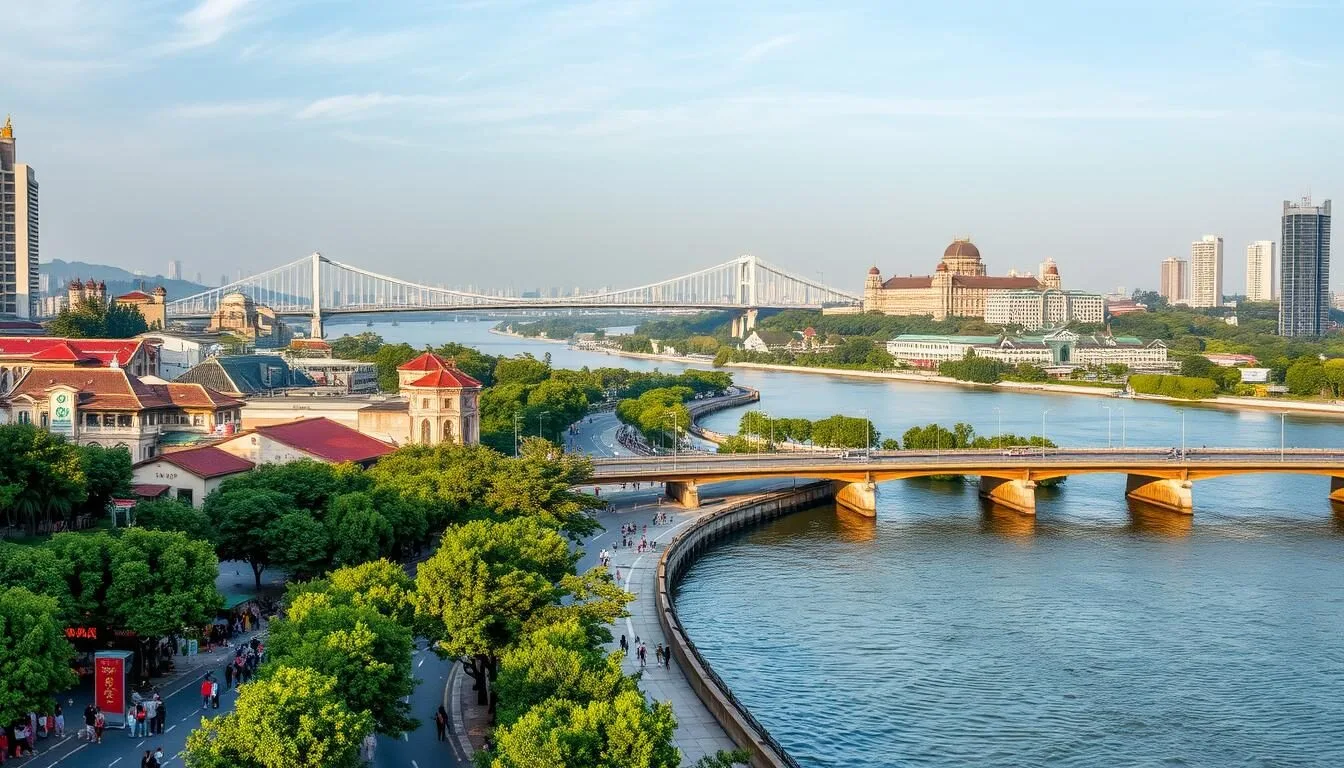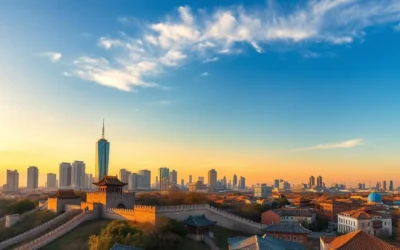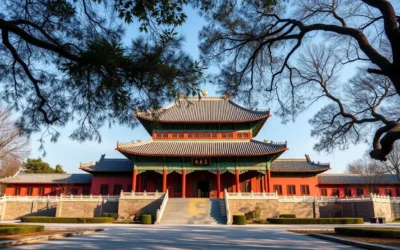✓ Accommodations✓ Flights✓ Rental Cars✓ Tours & Activities
Did you know that Wuhan, the capital of Hubei province, is a hidden gem waiting to be explored? As a major cultural, educational, and transportation hub in central China, this vibrant city offers a unique blend of historical landmarks, natural beauty, and rich cultural experiences.
As you plan your trip to this fascinating place, you’ll discover that Wuhan is divided into three towns and serves as a major transportation hub along the Yangtze River. This comprehensive guide will help you navigate the city‘s top attractions, from iconic landmarks like the Yellow Crane Tower to the serene East Lake and the Hubei Provincial Museum.
With its perfect blend of history, culture, and natural beauty, Wuhan is an ideal destination for travelers looking to explore a new city in China. Get ready to uncover the best of Wuhan with our expert guide.
Discovering Wuhan: China’s Hidden Gem
With its fascinating history and vibrant culture, Wuhan is a destination that will captivate your senses. As you explore this city, you’ll discover a unique blend of traditional and modern attractions that make it a worth visit destination.
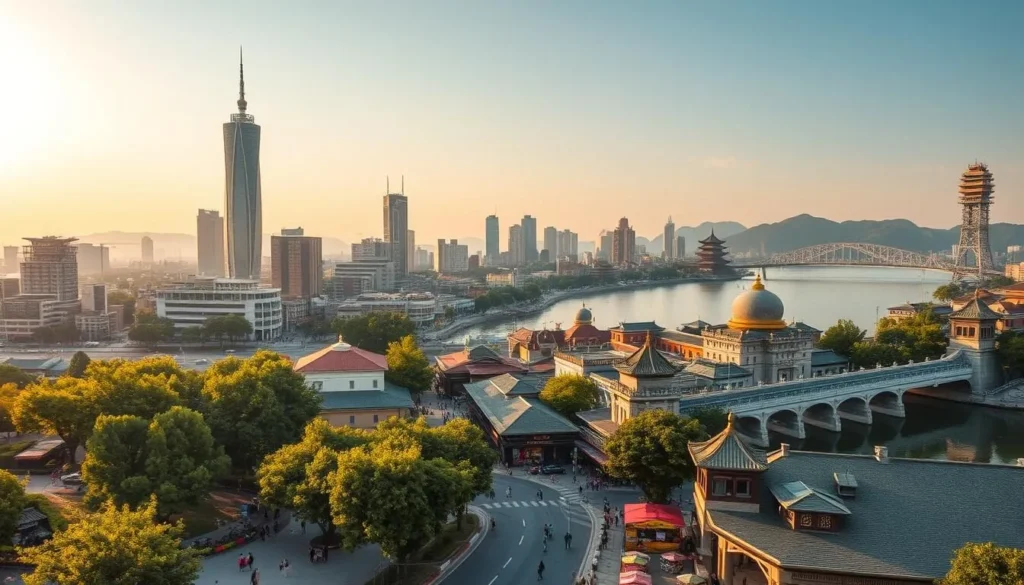
The Three Towns of Wuhan
Wuhan is a city formed by the merger of three historic towns: Wuchang, Hankou, and Hanyang. In 1927, these towns came together to create the vibrant metropolis you see today. Each town has its own distinct character, offering visitors a diverse range of experiences and architectural styles to explore.
Wuchang is known as the cultural and educational center, boasting landmarks like the Yellow Crane Tower and several prestigious universities. Hankou, on the other hand, is the commercial hub, featuring colonial architecture that reflects its history as a major trading center. Hanyang, often referred to as the industrial area, is home to numerous spiritual sites, adding to the city’s rich cultural tapestry.
Why Wuhan Deserves Your Attention
Wuhan’s strategic location at the confluence of the Yangtze and Han Rivers has shaped its history as a major transportation and trading center for over 3,500 years. This place has been a significant cultural and economic hub, making it an attractive destination for travelers seeking an authentic experience.
The city’s rich history, coupled with its stunning river views and fewer tourists compared to more popular destinations like Beijing or Shanghai, makes Wuhan a hidden gem waiting to be discovered. As you plan your trip to Wuhan, you’ll find that it offers a unique blend of cultural heritage and modern attractions that are sure to captivate your senses.
Best Time to Visit Wuhan
When planning your time visit to Wuhan, it’s essential to consider the best seasons to experience the city’s beauty. Spring, particularly March and April, is an ideal time visit due to the breathtaking cherry blossoms that bloom throughout the city.
Autumn, from September to November, is another excellent season to visit, offering comfortable temperatures and colorful foliage. While summer can be quite hot, earning Wuhan the nickname “one of China’s three furnaces,” and winters can be chilly, the spring and autumn seasons make Wuhan a worth visit destination for travelers seeking pleasant weather.
In conclusion, Wuhan is a city that offers a unique blend of cultural heritage, historical significance, and modern attractions, making it an ideal place to visit. With its three distinct towns, Wuhan provides a diverse range of experiences for travelers. Whether you’re planning a trip during the spring, autumn, or any other season, Wuhan is sure to leave a lasting impression.
Yellow Crane Tower: Wuhan’s Iconic Landmark
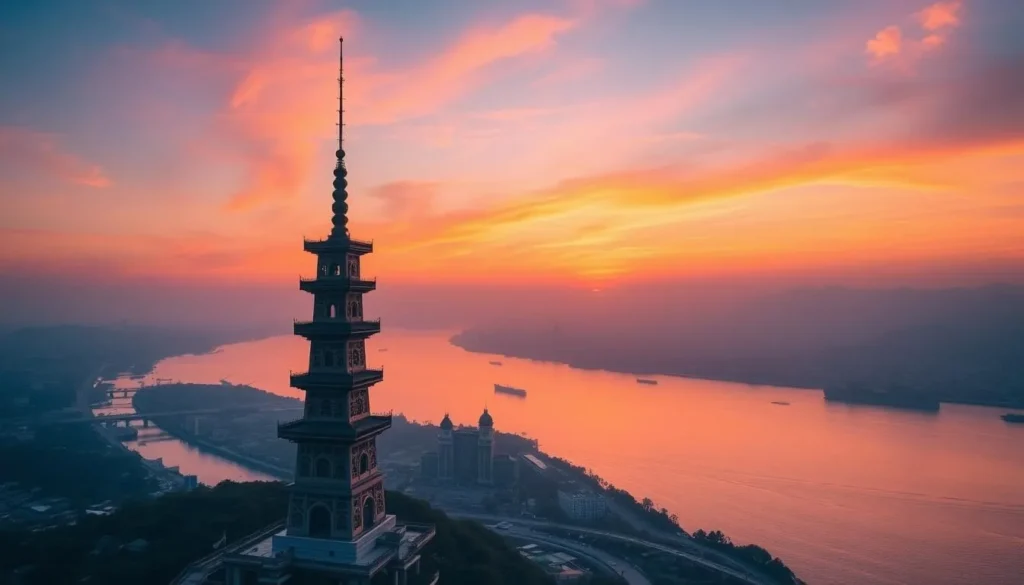
The Yellow Crane Tower, Wuhan’s most revered landmark, is a must-visit destination for anyone interested in history, culture, and breathtaking views. Perched on Snake Hill, this 5-story yellow structure has inspired countless poems and paintings throughout Chinese history. As you explore this iconic place, you’ll uncover the rich cultural heritage that makes Wuhan so unique.
History and Cultural Significance
The Yellow Crane Tower boasts a rich history dating back to 223 AD, making it a significant cultural heritage site. Its connection to famous Tang Dynasty poet Li Bai and his poem “Farewell to an Old Friend at Yellow Crane Tower” adds to its cultural significance. Over the centuries, the tower has been rebuilt and restored, yet it remains a testament to Wuhan’s enduring legacy.
What to See Inside the Tower
As you climb to the top of the Yellow Crane Tower, the panoramic views of the Yangtze River and Wuhan’s skyline unfold before your eyes. Inside, you’ll discover ancient artifacts, calligraphy exhibitions, and historical displays that narrate the tower’s thousand-year story. The top floor offers a stunning view of the city, making it a worth visit destination for anyone traveling to Wuhan.
Yellow Crane Tower Night Tour Experience
Experience the Yellow Crane Tower in a whole new light with the night tour. For 120 RMB per person, you’ll witness an impressive light and shadow show that brings the tower’s history to life through illuminations and projections. It’s a truly magical experience that showcases the tower’s beauty in a different time of day.
Visitor Tips and Information
To make the most of your visit, it’s recommended to book tickets in advance to avoid weekend crowds. The tower is open from 8:30 AM to 5:00 PM, with the night tour offering a unique experience. Enter from the west gate for a closer walk to the main tower, and don’t forget your camera to capture the breathtaking views.
East Lake: Wuhan’s Natural Paradise
East Lake, spanning over 33 square kilometers, is Wuhan’s most beloved natural attraction, offering a mix of scenic beauty and recreational fun. As the largest urban lake in China, it provides a serene escape from the city’s hustle and bustle.
Cherry Blossom Season at East Lake
During the spring, East Lake transforms into a breathtaking spectacle as thousands of cherry trees burst into bloom. The cherry blossoms create a picturesque landscape that rivals Japan’s famous sakura, making it a must-visit place in Wuhan during March and April. Visitors can stroll along the lake’s pathways, taking in the beautiful scenery and enjoying the vibrant colors.
Cycling Around the Lake
Cycling is a popular activity at East Lake, with well-maintained greenways that wind through scenic landscapes. You can rent bikes at multiple locations and explore recommended routes like Tingtao Road and Moshandao, passing by Huxin Island and Luoyan Scenic Area. This leisurely ride offers a unique perspective on the lake and its surroundings.
East Lake Eye Ferris Wheel
For a panoramic view of East Lake, take a ride on the East Lake Eye Ferris wheel. This 13-minute ride offers breathtaking views of the lake and the city, especially during sunset. At just 30 RMB per person, it’s an affordable and memorable experience.
Moshanshan Scenic Area
The Moshanshan Scenic Area is a highlight of East Lake, offering hiking trails and stunning views from the Chutian Terrace. Visitors can explore the area and enjoy the serene scenery, making it an ideal spot for nature lovers and photographers.
Best Seasonal Activities
East Lake is a year-round destination, with each season offering unique experiences. In spring, enjoy the cherry blossoms. Summer is perfect for boating and water activities. Autumn brings colorful foliage, especially at Maple Mountain, while winter is ideal for see cherry blossoms is not a winter activity, but you can enjoy bird watching at Luoyan Scenic Area. The park is always lively, making East Lake a great place to visit any time of the year.
Hubei Provincial Museum: Journey Through History
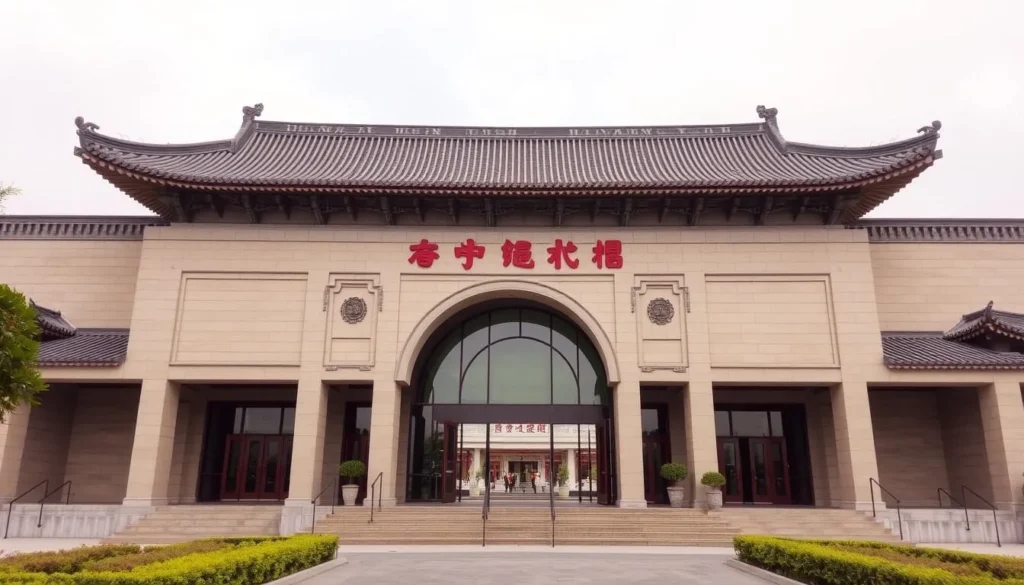
The Hubei Provincial Museum is a treasure trove of history, housing over 200,000 artifacts that tell the story of the Hubei region’s rich cultural heritage. As you step into this magnificent museum, you are about to embark on a journey through time, exploring the depths of Chinese history.
Marquis Yi’s Bronze Bells
One of the museum’s most prized possessions is the 2,400-year-old set of 65 bronze bells from Marquis Yi’s tomb. These bells are not only an engineering marvel but also a musical wonder, capable of playing complete musical scales. The daily performances at 11:00 AM and 3:00 PM bring this ancient music to life, offering visitors a unique experience. The story behind these bells is fascinating, reflecting the advanced craftsmanship and cultural practices of the time.
Experience the sound of history as the bronze bells resonate through the museum, providing a glimpse into the musical traditions of ancient China.
King Goujian’s Sword and Other Treasures
The Hubei Provincial Museum is also home to the legendary Sword of King Goujian, a 2,500-year-old weapon that remains sharp and virtually untarnished despite its age. This sword, along with other remarkable treasures like jade burial suits and ancient pottery, showcases the advanced craftsmanship of ancient Chinese civilizations. Each artifact tells a story of the people who lived during that era, their beliefs, and their way of life.
As you explore the museum, you will come across a myriad of historical relics that highlight the cultural and historical significance of the Hubei region.
Museum Performances and Exhibitions
The museum is not just a collection of artifacts; it’s an immersive experience. The bronze bell performances, multimedia displays, and special temporary exhibitions that rotate throughout the year bring history to life. These interactive exhibitions make the museum a worth visit destination for families and history enthusiasts alike.
Visitors, especially kids, can engage with history in a fun and interactive way, making the Hubei Provincial Museum an ideal for a family outing.
Practical Visitor Information
To make the most of your visit, it’s essential to plan ahead. The museum offers free admission, but visitors need to reserve tickets three days in advance. The museum is open from 9:00 AM to 5:00 PM and is closed on Mondays. English audio guides and AR devices are available for rent, enhancing your understanding and experience of the exhibits. With this information, you can plan your visit effectively and enjoy your time at this historical .
Yangtze River Experiences

As China’s longest river, the Yangtze River is a defining feature of Wuhan, waiting to be explored. The city’s unique position at the confluence of the Yangtze and Han Rivers makes it an ideal location to experience the river’s grandeur.
Walking the Yangtze River Bridge
Walking across the historic Yangtze River Bridge is an experience not to be missed. Completed in 1957, this bridge was China’s first modern bridge over the Yangtze River. Spanning about 1.6 km, it offers spectacular views of the river and the city skyline. You can also take the elevator at the bridgehead fortress to the top for a panoramic view of the confluence of the two rivers, all for just 2 RMB/person.
Night Cruise on the Yangtze
A night cruise on the Yangtze River, known as the Two Rivers Tour, is a magical experience. For 120 RMB/person, you can enjoy the cool evening breeze while witnessing Wuhan’s illuminated skyline. The cruise offers a unique perspective on the city’s “Endless Night of Jiangcheng” and features a riverside light show from the deck.
Riverside Parks and Promenades
The banks of the Yangtze River are lined with beautiful riverside parks and promenades, such as Hankou Riverside Park and Wuchang Riverside Park. These areas are perfect for morning exercises, sunset strolls, or simply watching the river traffic. They offer a serene escape from the city’s hustle and bustle.
Best Spots for River Views
For the best views and photos of the Yangtze River, head to the Yellow Crane Tower, the observation deck at the Yangtze River Bridge bridgehead fortress, or the riverside areas near Wuhan Customs House. These spots offer breathtaking views of the river and the city, especially during the evening when the skyline is illuminated.
Tanhualin: Wuhan’s Artistic Quarter

Tanhualin, Wuhan’s most artistic quarter, is a must-visit destination. This charming historic district is a 1.2-kilometer pedestrian street lined with beautifully preserved buildings from the late 19th and early 20th centuries, creating a unique atmosphere that feels like stepping back in time.
Historic Architecture and Atmosphere
The architecture in Tanhualin is a blend of Chinese traditional elements and Western influences from the former foreign concessions. As you walk through the area, you’ll feel like stepping into a different era, surrounded by the charm of old Wuhan. The historic buildings, with their intricate details and classic designs, make Tanhualin a fascinating place to explore.
The atmosphere is further enhanced by the narrow alleys and traditional courtyards, which add to the area’s nostalgic feel. You’ll find that every corner of Tanhualin offers a new and interesting view, making it a photographer’s paradise.
Bookstores and Cafés
Tanhualin is also known for its collection of independent bookstores and cozy cafés. You can visit the renowned Chengyu Zhen Bookstore and Visual Book House, where you can browse through rare books while enjoying specialty coffees and teas. These bookstores are not just about reading; they’re an experience, offering a quiet retreat from the bustling city.
Art Galleries and Creative Spaces
The neighborhood is home to numerous art galleries and creative spaces showcasing works by local artists. You’ll find artisanal shops selling handcrafted goods and regular cultural events that attract Wuhan’s artistic community. Tanhualin is a hub for creativity, making it an inspiring place to visit.
Photography Spots in Tanhualin
Tanhualin offers many great spots for taking memorable photos. The Old City Wall ruins and the former Renji Hospital are popular for vintage photo shoots. You can also capture the beauty of traditional courtyards and picturesque alleyways, where every corner provides an Instagram-worthy scene of historic Wuhan.
Spiritual Wuhan: Temples and Religious Sites
Wuhan’s spiritual landscape is dotted with significant Buddhist temples and religious sites that offer a serene escape from the city’s bustle. As you explore these sacred places, you’ll discover a rich history and architecture that reflects the city’s cultural heritage.
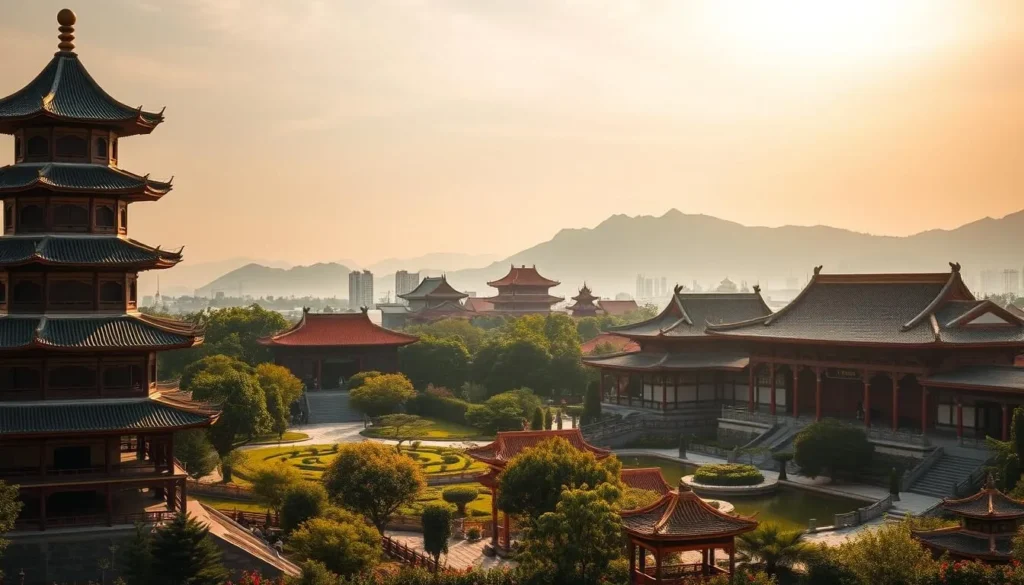
Guiyuan Temple: Architectural Marvel
Guiyuan Temple, established in 1658, is a standout example of classical Chinese architecture. This temple is renowned for its collection of 500 unique clay arhat statues, each with incredibly lifelike expressions. As you walk through the temple grounds, you’ll be struck by the beautiful garden design, which adds to the tranquil atmosphere of the place.
The temple’s architecture is a testament to the skill of ancient craftsmen, with intricate carvings and ornate details that adorn every corner of the buildings. You can spend a considerable amount of time exploring the temple’s various halls and courtyards, taking in the history and significance of this sacred site.
Gude Temple’s Unique Design
Gude Temple is a fascinating blend of different architectural styles, including Gothic, Islamic, and Indo-Burmese influences. This unique fusion makes it a standout among Chinese temples. One of the temple’s most striking features is the Nine Buddha Pagodas in the Yuantong Hall, which symbolize “The Supreme Emperor.”
As you explore Gude Temple, you’ll notice the intricate details and ornate decorations that reflect its rich history. The temple is open from 8:30 AM to 4:00 PM, and tickets cost 13 RMB, including incense. For the best photography, visit during the early morning or evening when the soft light enhances the temple’s beauty. Wearing plain, long dresses can also help you capture better shots.
Baotong Temple
Baotong Temple is one of Wuhan’s oldest religious sites, with a history spanning over 1,500 years. This ancient temple is known for its pagoda, tranquil atmosphere, and connection to the famous monk Xu Yun. As you visit Baotong Temple, you’ll experience a deep sense of peace and connection to the city’s spiritual heritage.
Visiting Etiquette and Tips
When visiting Wuhan’s temples and religious sites, it’s essential to be mindful of local customs and etiquette. Dress modestly, avoiding revealing clothing, and be respectful during prayer times. Some areas may have photography restrictions, so be sure to check before taking pictures. Understanding and respecting these customs will enhance your experience and allow you to appreciate the spiritual atmosphere of these sacred places.
By taking the time to explore Wuhan’s spiritual landmarks, you’ll gain a deeper appreciation for the city’s rich cultural heritage and the significance of these religious sites in the daily lives of locals.
Wuhan, China: Best Things to Do – Top Picks for Food Lovers
Wuhan, a city in central China, is a paradise for food lovers, offering a unique blend of local cuisine that can’t be found elsewhere. The city’s culinary scene is a reflection of its rich history and cultural diversity, making it a fascinating place for culinary exploration.
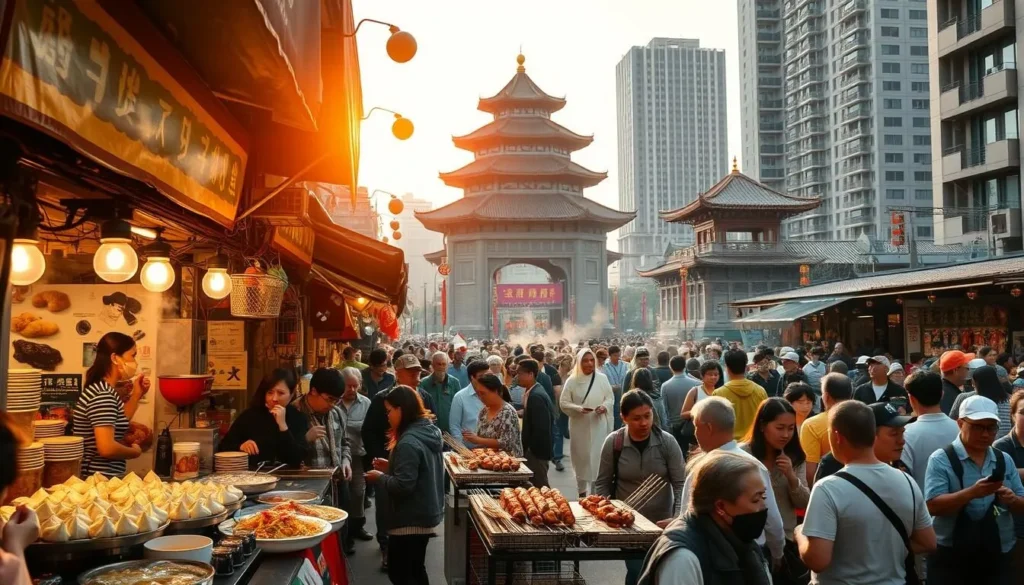
Hot Dry Noodles: Wuhan’s Signature Dish
Hot Dry Noodles, or “reganmian,” is Wuhan’s signature breakfast dish and culinary claim to fame. This dish features springy noodles coated in sesame paste, pickled vegetables, and spices. For an authentic experience, visit Cailinji, known for its black sesame sauce, or Luo’s Hot Dry Beef Noodle Shop, which serves freshly boiled beef hot dry noodles. You can pair your noodles with egg wine for a traditional Wuhan breakfast.
Three-Delicacy Doupi and Mianwo
Another culinary delight in Wuhan is the Three-Delicacy Doupi, a savory crepe made from mung bean skin and filled with sticky rice, fresh meat, eggs, and shrimp. Lao Tongcheng is the go-to place for this local specialty, offering a golden crispy outer skin that’s irresistible. Additionally, try Mianwo, a crispy outside and glutinous inside fried dough, best enjoyed when dipped in Hu Tangfen soup, found next to Xu Sao’s Hu Tangfen stall.
Best Breakfast Spots in Wuhan
Wuhan’s vibrant breakfast culture is worth experiencing. The city offers numerous morning food streets and stalls where locals queue for favorites like mianwo, egg wine, and fresh doupi. Visiting these spots gives you a taste of the local lifestyle and the opportunity to try a variety of dishes in one place. It’s a great way to start your day in Wuhan.
Late Night Food Scene
Wuhan’s late-night food scene is exciting, with smoky barbecue stalls, spicy crayfish restaurants, and street food vendors keeping the city’s culinary energy going until the early hours of the morning. For a memorable experience, head to Liangliang Steamed Shrimp for oil-braised big shrimp, steamed shrimp, and cold noodles. Alternatively, Xiaomin Food Stall is a must-visit for chicken feet, dried bean curd strips, and edamame. The night food scene in Wuhan is not to be missed.
| Dish | Description | Recommended Place |
|---|---|---|
| Hot Dry Noodles | Springy noodles with sesame paste and pickled vegetables | Cailinji or Luo’s |
| Three-Delicacy Doupi | Savory crepe with sticky rice, meat, eggs, and shrimp | Lao Tongcheng |
| Mianwo | Crispy outside, glutinous inside fried dough | Next to Xu Sao’s Hu Tangfen stall |
Street Food Adventures in Wuhan
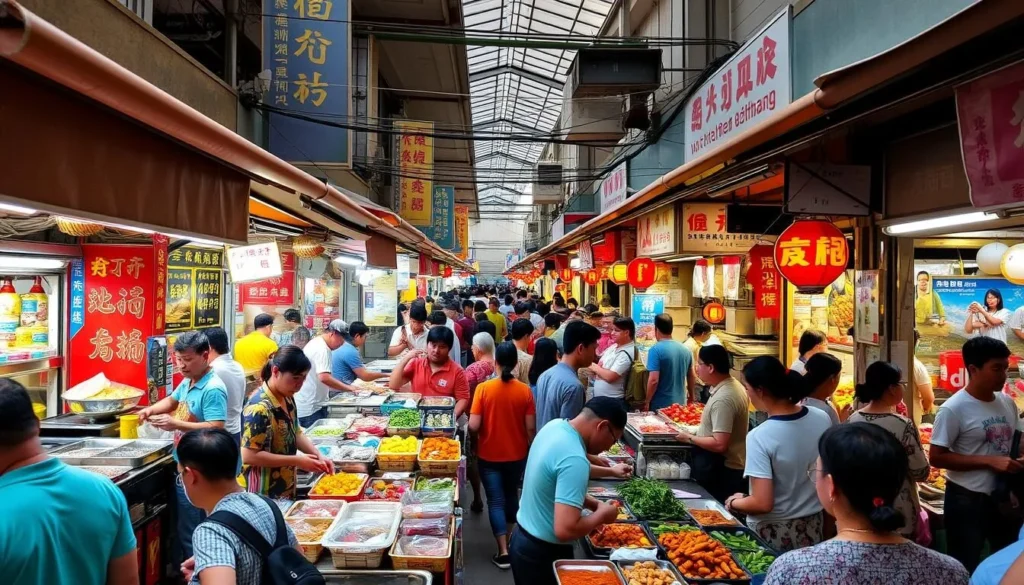
As you explore Wuhan, you’ll discover a world of flavors on every corner. The city’s vibrant street food culture is an essential part of its identity, where locals and visitors can find delicious, affordable treats around every corner. Wuhan’s street food scene is a reflection of the city’s rich culinary heritage, offering a diverse range of dishes that cater to all tastes.
The streets of Wuhan are filled with the sights and smells of local cuisine, from savory snacks to sweet pastries. You can experience the authentic flavors of the city by visiting one of its many street food markets.
Liangdao Street Food Tour
Liangdao Street is one of Wuhan’s most authentic food streets, offering a variety of affordable and delicious options. On a food tour along Liangdao Street, you can sample specialties like Master Zhao’s fried cake wrapped shaomai, Thai-style red bean pastries, and Uncle Qin’s Guilin rice noodles. Meals here cost about 20 RMB per person, making it an affordable and enjoyable culinary experience.
The street is lined with food stalls, each offering its own unique dishes. You can try a range of local snacks and drinks, from mianwo (fried dough) to doupi (bean skin wraps).
Hubu Alley: Tourist Spot vs. Local Reality
Hubu Alley is Wuhan’s famous but touristy food street. While it’s a popular destination for visitors, the snacks here are often overpriced. For a more authentic experience, consider visiting Liangdao Street or Water Tower Street, where you can find local food at reasonable prices.
When eating at street stalls, be aware of the prices and quality of the food to avoid tourist traps. Locals prefer to eat at stalls with high turnover, ensuring freshness and quality.
Traditional Snacks to Try
Wuhan is known for its traditional snacks, including mianwo (fried dough), doupi (bean skin wraps), xiaolongtangbao (soup dumplings), duck neck, and various sweet rice cakes. These dishes are a must-try when visiting the city. You can find them at local street food stalls and markets.
Be adventurous and try different snacks to experience the full range of Wuhan’s culinary delights. Don’t be afraid to ask locals for recommendations on the best place to try these dishes.
Food Safety Tips
When enjoying street food in Wuhan, follow some basic safety tips. Look for busy stalls with high turnover, check for cleanliness, and understand pricing to avoid tourist traps. Learning basic Chinese phrases can also help when ordering food at local stalls.
By being mindful of these tips, you can have a safe and enjoyable dining experience during your trip to Wuhan. Enjoy exploring the local food scene!
Unique Cultural Experiences in Wuhan
Wuhan, a city steeped in history and culture, offers visitors a plethora of unique experiences to immerse themselves in its rich heritage. As you explore this vibrant city, you’ll have the opportunity to engage with its cultural traditions in various meaningful ways.
Zhiyin Hao: Immersive Historical Drama
The Zhiyin Hao is an immersive historical drama that takes you back to the Republic of China era. This unique experience allows you to don traditional attire, such as qipao or changshan, and board a vintage ship where you’ll watch a captivating play. The experience is made even more special by the interaction with actors, the gentle river breeze on the deck, and the nostalgic tunes from a gramophone. To make the most of this experience, it’s recommended to purchase tickets in advance, with prices ranging from 228 RMB per person on weekdays to 298 RMB per person on weekends. The 7:30 PM show is particularly highly recommended.
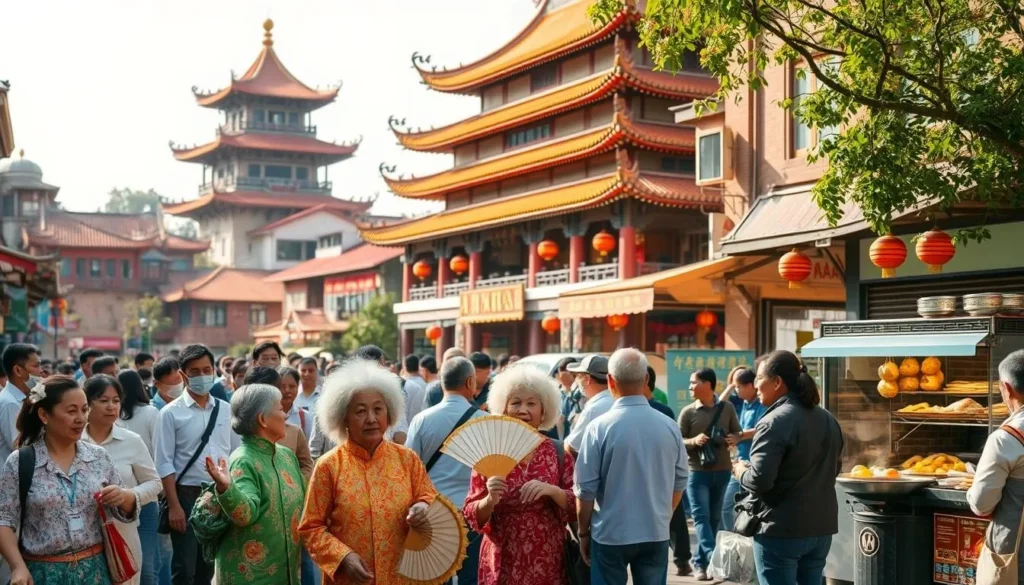
Traditional Tea Houses
Wuhan’s traditional tea houses offer a serene atmosphere where you can experience authentic Chinese tea ceremonies. As you sip on tea, you can listen to traditional music performances and observe locals gathering for tea, conversation, and games. These tea houses provide a glimpse into the local culture and are an excellent place to relax and unwind.
Wuhan Opera Performances
Wuhan is home to distinctive regional opera traditions, including Han Opera. You can experience this rich cultural heritage by attending performances at venues like the Wuhan Theater. Seasonal special shows are also worth looking out for, as they showcase the city’s vibrant cultural scene. Han Opera is known for its elaborate costumes, dramatic storylines, and unique vocal styles, making for a memorable experience.
Cultural Workshops and Classes
For a more hands-on cultural experience, Wuhan offers various workshops and classes. You can try your hand at traditional Chinese painting or calligraphy, practice tai chi by the serene East Lake, or participate in cooking classes focused on Wuhan’s signature dishes like hot dry noodles. These activities not only provide a deeper understanding of Wuhan’s culture but also offer a fun and interactive way to engage with the local community.
| Cultural Experience | Description | Price Range |
|---|---|---|
| Zhiyin Hao | Immersive historical drama | 228-298 RMB |
| Traditional Tea Houses | Authentic Chinese tea ceremonies | Free-50 RMB |
| Wuhan Opera Performances | Han Opera and other regional operas | 50-200 RMB |
| Cultural Workshops | Painting, calligraphy, tai chi, cooking | 100-300 RMB |
Where to Stay in Wuhan
Wuhan’s three districts – Wuchang, Hankou, and Hanyang – each provide unique accommodation experiences tailored to different interests and budgets. Whether you’re looking for luxury, boutique, or budget-friendly options, the city has a wide range of hotels and guesthouses to choose from.
Luxury Accommodations with River Views
For a luxurious stay with breathtaking views, consider hotels along the Yangtze River. The Wuhan Wanda Reign Hotel, located by East Lake, offers river-view rooms overlooking the Yangtze River Bridge, providing a high-end luxury experience.
Another top choice is the Wuhan Shangri-La, which boasts premium amenities and panoramic vistas of the Yangtze River.
Boutique Hotels in Historic Buildings
For a unique and culturally rich experience, boutique hotels housed in historic buildings are a great choice. The Hidden Tanhualin Residence is a renovated Republic of China old house with an artsy, retro atmosphere, within walking distance to Tanhualin.
The Wuhan Fengmao Andi Hotel is another example, combining art exhibitions and guest rooms in a century-old building with a strong design sense.
Budget-Friendly Options
Travelers on a budget can find comfortable and convenient accommodations in Wuhan. Guesthouses near Guiyuan Temple offer a peaceful, Zen-style atmosphere, ideal for those seeking a serene experience.
Image of a guesthouse near Guiyuan Temple
Reliable chain hotels like Hanting and 7Days Inn provide good value without sacrificing comfort or convenience.
Image of Hanting hotel lobby
Neighborhood Guide for Travelers
Choosing the right neighborhood to stay in Wuhan depends on your interests and preferences. Wuchang District is ideal for those interested in cultural attractions and universities.
Hankou District is perfect for shoppers and nightlife enthusiasts, offering a vibrant atmosphere.
Hanyang District provides a more local experience with fewer tourists, great for those looking to explore the authentic Wuhan.
By considering these options, you can select the best place to stay in Wuhan that fits your travel plans and budget.
Getting Around Wuhan
Navigating Wuhan is surprisingly convenient, thanks to its comprehensive transportation system. Whether you’re visiting for a short trip or traveling extensively within the city, Wuhan offers various options to suit your needs.
Navigating the Metro System
Wuhan’s modern and expanding metro system is a convenient way to travel across the city. With 11 lines covering most major attractions, you can easily get to where you need to go. The metro operates from 6:00 AM to 11:00 PM, making it a reliable option for both early risers and those who like to enjoy the city in the evening. To use the metro, you can purchase tickets or use the Wuhan Electronic Bus Card through Alipay, which makes scanning and riding a breeze.
Metro Lines and Major Attractions:
| Metro Line | Major Attractions |
|---|---|
| Line 1 | Yellow Crane Tower, Wuhan University |
| Line 2 | East Lake, Hubei Provincial Museum |
| Line 4 | Wuhan Railway Station, Hanan Highway |
Ferry Services Across the Yangtze
For a unique experience, consider taking the ferry across the Yangtze River. This mode of transportation not only gets you from one place to another but also offers spectacular views of the river and a glimpse into traditional river life. The ferry service from Zhonghua Road Pier to Wuhan Pass Pier costs just 1.5 RMB per person and operates from 7:00 AM to 8:00 PM. It’s a great way to see the city from a different perspective during your travel time.
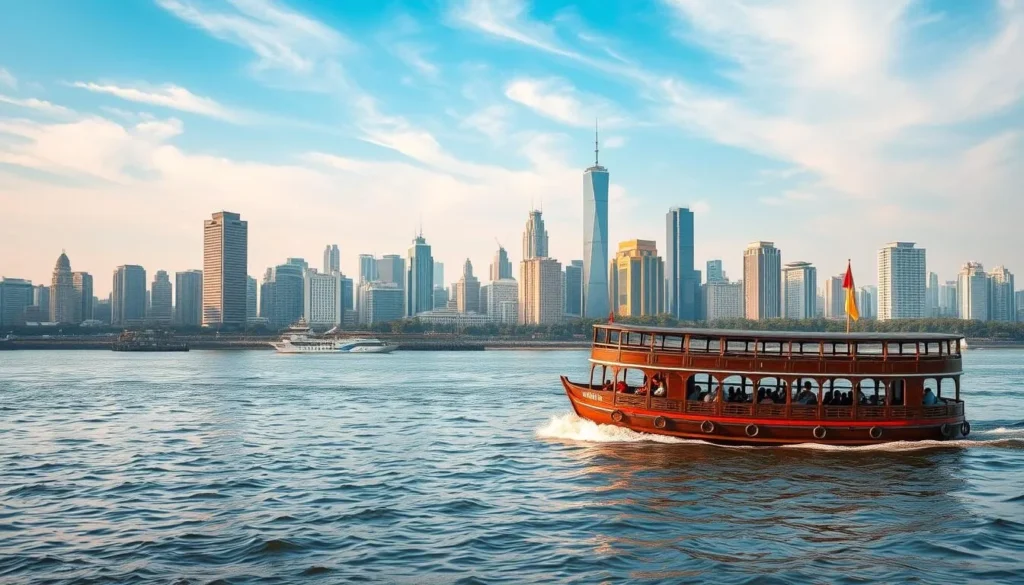
Buses and Shared Bikes
Wuhan has an extensive bus network that connects major attractions, making it easy to get around without a car. Tourist bus lines like 521 and 402 are particularly useful, as they link key places such as East Lake, Yellow Crane Tower, and the Provincial Museum. For shorter trips, shared bikes and electric scooters are available throughout the city, offering a pleasant way to ride around, especially in the old concession area of Hankou.
- Tourist bus lines: 521, 402
- Major attractions connected: East Lake, Yellow Crane Tower, Provincial Museum
- Shared bikes and electric scooters available citywide
Transportation Apps and Tips
To make the most of your time in Wuhan, consider using transportation apps like DiDi (China’s Uber) and Baidu Maps. These apps can help you navigate the city efficiently and avoid rush hour congestion between 7:30-9:00 AM and 5:30-7:00 PM. Additionally, the Metro China app is useful for planning your metro journeys. With these tips and tools, you’ll be well-equipped to explore Wuhan with ease.
By understanding and utilizing Wuhan’s comprehensive transportation system, you can enjoy a smooth and enjoyable trip, making the most of your time in this vibrant city.
Seasonal Highlights in Wuhan
From cherry blossoms in spring to plum blossoms in winter, Wuhan is a city that transforms with the seasons, offering something new to explore. This transformation makes Wuhan an exciting destination for travelers, with each season bringing its unique attractions and experiences.
Spring: Cherry Blossoms and Festivals
Spring is a spectacular time in Wuhan, with the city turning into one of China’s premier cherry blossom viewing destinations. The East Lake Cherry Blossom Garden and Wuhan University campus are particularly popular, drawing thousands of visitors to see the cherry trees in full bloom. The cherry blossoms typically bloom in mid-to-late March, creating a beautiful scenery that is not to be missed.
During this time, you can enjoy the vibrant atmosphere and participate in various festivals celebrating the blossoms. The Gesang Flowers at Mulan Grassland also bloom in April and May, extending the spring floral experience.
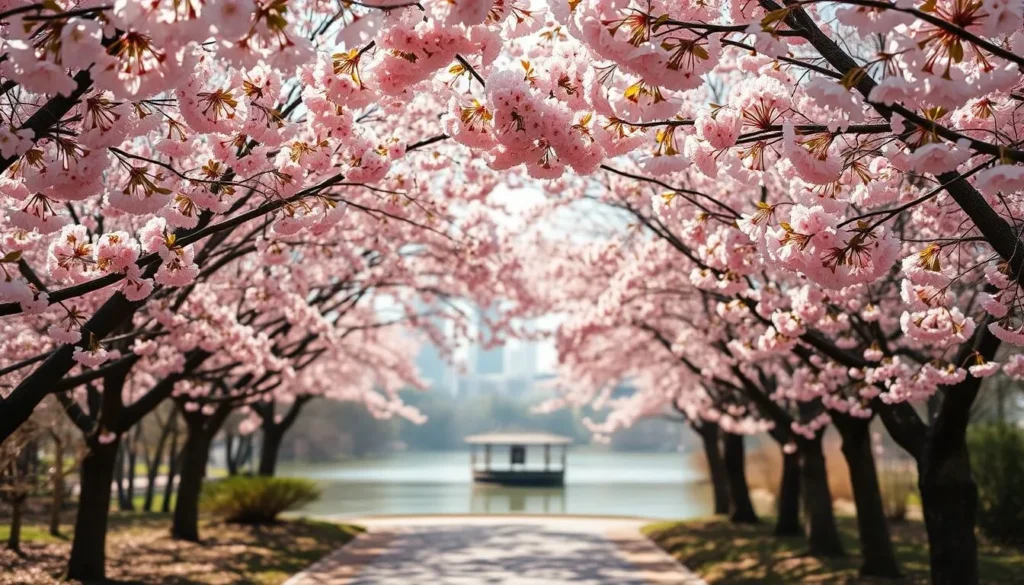
Summer: Water Activities and Evening Events
Summer in Wuhan is characterized by hot weather, but the city offers several ways to cool off. You can enjoy water activities at East Lake Lingbo Gate or visit Maya Beach Water Park for a fun day out. The Yangtze River Night Cruises are another great way to experience the city’s beauty while staying cool.
Evening events and night markets add to the city’s vibrant atmosphere during the summer months, providing a lively place to be after dark.
| Season | Main Attractions | Activities |
|---|---|---|
| Spring | Cherry Blossoms at East Lake and Wuhan University | Viewing Cherry Blossoms, Festivals |
| Summer | East Lake, Maya Beach Water Park | Water Activities, Night Cruises |
| Autumn | Mulan Tianchi Red Leaves, Qingchuan Pavilion Osmanthus | Foliage Viewing, Harvest Celebrations |
| Winter | East Lake Plum Garden, Guiyuan Zen Temple | Viewing Plum Blossoms, Visiting Temples |
Autumn: Foliage and Harvest Celebrations
Autumn is perhaps the most pleasant season to visit Wuhan, with comfortable temperatures and beautiful foliage. Mulan Tianchi Red Leaves and the Qingchuan Pavilion Osmanthus are highlights, offering stunning natural scenery. The golden reed marshes along the Yangtze River add to the picturesque landscape.
This season is also a time for harvest celebrations, allowing visitors to experience the local culture and traditions.
Winter: Plum Blossoms and Hot Springs
Winter brings a different kind of beauty to Wuhan, with the East Lake Plum Garden being a must-visit for its delicate plum blossoms. For those looking to relax, the hot spring resorts outside the city offer a serene escape from the cold.
Indoor cultural experiences, such as visiting temples and museums like the Guiyuan Zen Temple, provide a warm and enriching experience during the colder months.
Wuhan’s seasonal highlights make it a versatile destination, catering to a wide range of interests and preferences throughout the year. Whether you’re interested in natural beauty, cultural experiences, or simply exploring a new place, Wuhan has something to offer in every season.
Day Trips from Wuhan
Beyond Wuhan’s city limits lies a treasure trove of day trip opportunities waiting to be discovered. Whether you’re interested in natural beauty, cultural heritage, or outdoor adventures, the surrounding region has something to offer.
Mulan Mountain and Grasslands
Mulan Mountain and Grasslands, approximately two hours from Wuhan, is a must-visit destination for nature lovers. The area is renowned for its stunning natural scenery, featuring Gesang Flowers in spring and vibrant red leaves in autumn. Visitors can explore the Mulan Temple, dedicated to the legendary female warrior, and enjoy various outdoor activities such as hiking and grassland skiing.
Ancient Towns Near Wuhan
Wuhan is surrounded by ancient towns that offer a glimpse into the region’s rich cultural heritage. Huangpi Ancient Town and Xinzhou Ancient Town are two such places where visitors can experience well-preserved Ming and Qing dynasty architecture, traditional tea houses, and authentic local life. These towns provide a serene escape from the hustle and bustle of city life, allowing travelers to immerse themselves in the local culture.
Natural Parks and Reserves
For those seeking to connect with nature, Jiugongshan National Forest Park and the Xingshan section of the Three Gorges are excellent day trip options from Wuhan. Jiugongshan boasts diverse ecosystems and hiking trails, while the Xingshan section offers breathtaking river scenery. These natural places provide ample opportunities for outdoor adventures and appreciating the region’s natural beauty.
Transportation Options for Day Trips
Getting to these day trip destinations is convenient, with various transportation options available. Travelers can choose from organized tours, public buses, private car rentals, and high-speed trains, depending on the destination and personal preference. Planning your trip in advance can help ensure a smooth and enjoyable journey.
In conclusion, Wuhan serves as an ideal base for exploring the surrounding region, with a variety of day trip options catering to different interests. Whether you’re looking to experience natural beauty, cultural heritage, or outdoor adventures, there’s a day trip from Wuhan that’s right for you.
Practical Travel Tips for Visiting Wuhan
To make the most of your visit to Wuhan, understanding the local customs, weather, and travel tips is crucial. Wuhan, being a significant city in China, has its unique characteristics that can make your trip more enjoyable if you’re well-prepared.
Weather Considerations and What to Pack
Wuhan experiences a humid subtropical climate with four distinct seasons. Summers are notoriously hot and humid, with temperatures often reaching above 35°C (95°F). To cope with the heat, pack lightweight, breathable clothing, sunscreen, sun hats, and portable fans. Huoxiang Zhengqi water is also recommended to help with heat-induced discomfort.
In contrast, winters can be quite chilly, with temperatures sometimes dropping below 0°C (32°F). Bringing layers and a warm jacket is advisable. Spring and autumn are generally mild, but it’s still a good idea to pack light jackets for the temperature differences between day and night.
| Season | Weather | Packing Tips |
|---|---|---|
| Summer | Hot and Humid | Lightweight, breathable clothing, sunscreen, sun hats, portable fans |
| Winter | Cold | Layers, warm jacket |
| Spring/Autumn | Mild | Light jackets for temperature differences |
Language Tips and Common Phrases
While Mandarin Chinese is the primary language spoken in Wuhan, English is not as widely spoken as in major cities like Beijing or Shanghai. Learning a few basic phrases can go a long way in making your trip smoother. Addressing locals respectfully as “Shifu” (master) is a friendly way to interact. Bus announcements are often in Wuhan dialect, so it’s helpful to listen carefully for “Next stop: XXX.”
- Learn basic Mandarin phrases like “hello” (nǐ hǎo), “thank you” (xiè xiè), and “excuse me” (duì bù qǐ).
- Use a translation app to help with more complex conversations.
Money-Saving Strategies
Wuhan offers various opportunities to save money while traveling. Using the Wuhan Tourism Card can provide discounts at various attractions. Visiting free attractions like parks and lakes, taking advantage of free museum days, eating at local establishments away from tourist areas, and using public transportation are effective ways to cut costs.
Some specific money-saving tips include reserving free tickets in advance for the Provincial Museum and Yellow Crane Tower, using student and senior IDs for discounts, choosing the “Two Rivers Tour” ordinary cruise for night Yangtze tours, and picking community old shops for breakfast.
| Money-Saving Tip | Description |
|---|---|
| Wuhan Tourism Card | Offers discounts at various attractions |
| Free Attractions | Visit parks and lakes |
| Free Museum Days | Take advantage of free entry days at museums |
Safety and Health Information
Staying safe and healthy is paramount while traveling. Make sure to have emergency numbers handy and consider recommended vaccinations before your trip. During Wuhan’s hot summers, staying hydrated and avoiding excessive sun exposure is crucial. Knowing the locations of international hospitals can also provide peace of mind.
Avoiding Tourist Traps
Being aware of common tourist traps can save you from unnecessary hassles. Be wary of “free guiding” around Yellow Crane Tower, as these are often scams. Refuse aggressive sales pitches, especially in popular tourist areas. Opt for eating at local eateries like Liangdao Street or Water Tower Street instead of overpriced places in Hubu Alley.

By being informed and prepared, you can have a more enjoyable and stress-free trip to Wuhan. Whether it’s navigating the city’s metro system, enjoying the local cuisine, or visiting historical sites, these practical tips will help you make the most of your time in this vibrant city.
Conclusion
As you conclude your journey through Wuhan, the memories of its rich history, natural beauty, and vibrant culture linger. This city, often described as “the poetry and distance of Yellow Crane Tower, the blue waves and cycling of East Lake, the bronze bells and King Goujian’s sword of the Provincial Museum, the sunset and ferry of the Yangtze River Bridge,” offers a unique travel experience that blends grand historical landmarks with everyday pleasures.
Wuhan is a multifaceted destination that caters to diverse interests, providing travelers with a perfect blend of historical significance, natural beauty, cultural experiences, and culinary adventures. Unlike China’s more famous cities, Wuhan offers an authentic insight into contemporary Chinese urban life without the overwhelming crowds, making it an ideal place for those seeking a deeper cultural understanding.
Some of the most memorable experiences in Wuhan include climbing the iconic Yellow Crane Tower for panoramic views, cycling around East Lake during the cherry blossom season, cruising the Yangtze River at sunset, exploring the artistic quarter of Tanhualin, and savoring authentic hot dry noodles. These experiences not only showcase the city’s diverse attractions but also highlight its ability to balance tradition with modernity.
While Wuhan gained international attention during the COVID-19 pandemic, the city has since recovered and continues to develop as a vibrant metropolis. It welcomes visitors with warmth and resilience, offering a fresh perspective on Chinese culture and urban life. For travelers planning a trip to China, Wuhan is a destination that should not be missed.
Considering Wuhan as part of your China itinerary can enhance your travel experience. An ideal trip duration of 3-5 days allows you to explore the city’s main attractions and get a feel for local life. Additionally, Wuhan can be combined with other destinations in central China for a more comprehensive travel experience, making it a valuable addition to any traveler’s China trip plans.
In conclusion, Wuhan is a city that offers rich travel experiences and cultural attractions, making it a must-visit destination for travelers. With its unique blend of history, culture, and natural beauty, Wuhan is sure to leave a lasting impression on all who visit.
The above is subject to change.
Check back often to TRAVEL.COM for the latest travel tips and deals.
